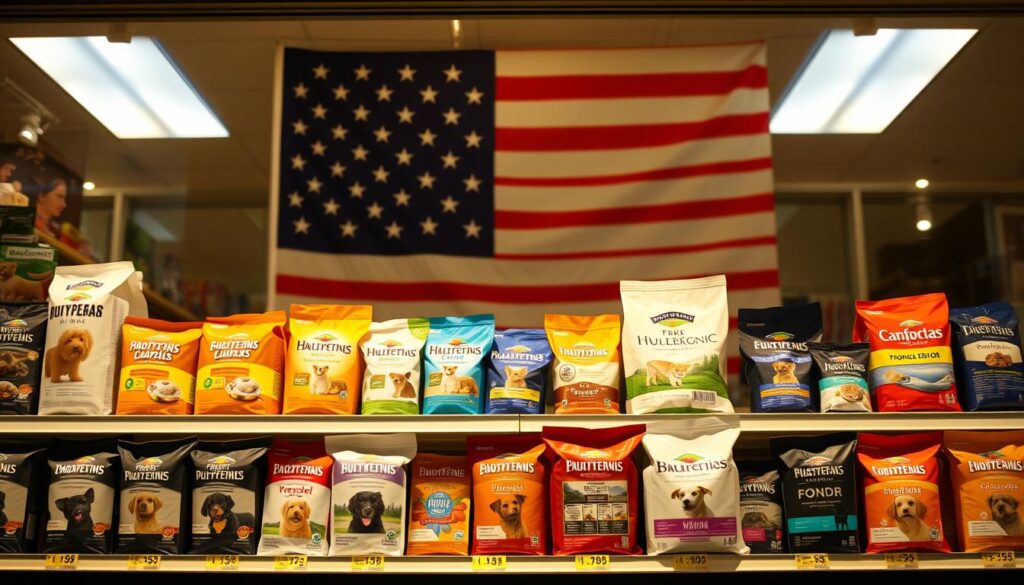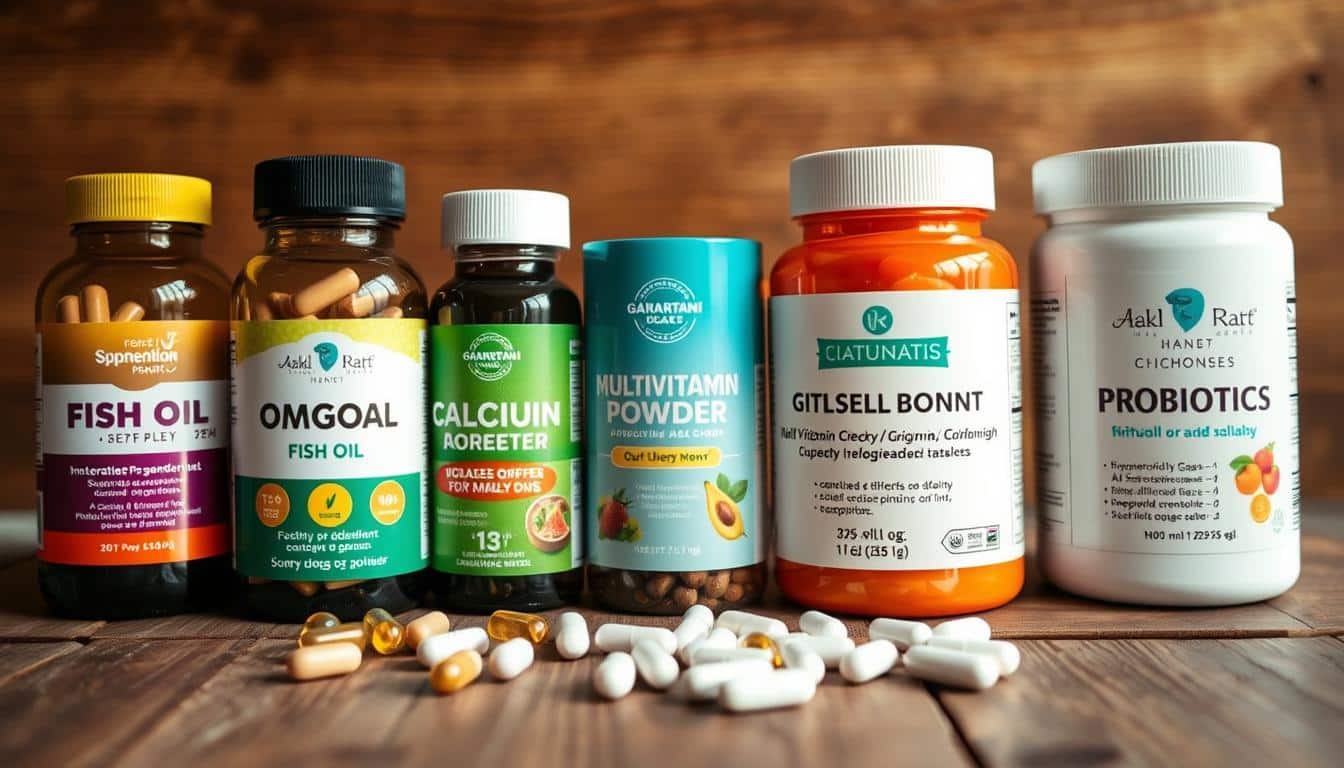Toy breeds often react to foods differently than bigger dogs do. Their food should have fewer ingredients to help with stomach or skin issues. This is key for breeds like Chihuahuas, Yorkshire Terriers, and Maltese. Finding the right food means understanding that each dog is unique.
Experts at PetMD and Chewy, including vets and vet techs, review lists of allergy-friendly foods. They suggest special diets for dogs with true food allergies. Owners should look at the food’s life stage, how big the kibble is, and its calories before switching. Hunting for the right food may lead to trying foods with one ingredient or exotic meats like salmon or venison.
Places like Dog Food Advisor and vet’s offices point to hydrolyzed protein and one-ingredient foods as good options. You can find brands like Purina Pro Plan and Merrick that cater to sensitive stomachs in toy breeds. These brands offer a balance between cost and convenience for daily use.
Always check with a vet before changing your dog’s diet. Tests can make sure your dog’s issues are from the food, not something more serious. The right hypoallergenic food can make a big difference for your small, sensitive friend.
Why hypoallergenic diets matter for toy breeds
Toy breeds need special diets. They burn energy quickly and have a high heart rate. To match their metabolism, food must be right. Small bites and calorie-rich food help keep their weight steady. It also avoids quick changes in blood sugar that can upset their tummy or mood.
The way toy breeds are built affects their health. They have short guts and sensitive skin. This makes it easier to spot issues but harder to deal with them. As they age, their calorie needs change. So, it’s important to have food for puppies, adults, and seniors to keep them healthy.
Skin or ear problems usually mean something’s not right. Look out for scratching, ear infections happening a lot, and dry skin. Signs of allergies in small dogs may include licking their paws, teary eyes, losing fur, and tummy troubles like throwing up or diarrhea.
Allergies come in various types. Dogs can have food or environmental allergies with similar symptoms, but different causes. Food allergies often cause upset stomachs and skin issues due to certain proteins. Meanwhile, things like pollen or dust mites lead to itchy skin and ear infections during certain seasons.
When you notice symptoms, take action in steps. First, cut out human food and snacks. If problems stay, see a vet to exclude other medical issues. Then, you might start a food elimination trial.
- Think about getting tests: stool tests, skin checks, and a full exam to rule out other issues.
- Try diets with few ingredients with a vet’s help to find what causes the allergy without sacrificing nutrition.
- If you think it’s a food allergy caused by the immune system, special vet-prescribed food might be needed.
Working with a vet makes things easier. A vet can help set up an elimination trial and suggest how to safely change foods. Seeing a vet early and doing the right tests can save your little dog from a lot of trouble. It also helps you find a diet that keeps them allergy-free.
How veterinarians and experts select allergy-friendly foods
Choosing the right food for dogs with allergies takes careful work. Experts use their clinical knowledge, lab results, and facts about how the food is made. They look at many details to find the safest options for dogs that might have allergies. This is how they make their choices.
Role of veterinary panels and experienced reviewers
- At Chewy and PetMD, veterinary groups have vets and vet techs who look at food recipes. They use their real-world experience and information from the food makers.
- Experts in animal nutrition confirm if diets meet dogs’ medical needs. They look at nutrient details and tests.
- Sites like Dog Food Advisor check the ingredients and nutrition of food while being open about their partners.
Criteria used: ingredients, manufacturing, research, and price
- The search for the right dog food begins with what’s in it and types of proteins used, focusing on less common ones.
- Experts make sure the food has the right nutrients, follows AAFCO guidelines, and there’s research or tests to back it up.
- Price and if you can easily get the food matter too. Good quality yet affordable foods are preferred for daily feeding.
Importance of therapeutic (prescription) diets for true food allergies
- If a dog truly has a food allergy, vets often suggest special prescription diets. These diets are made carefully to make sure they really help.
- These special foods meet strict nutritional needs and are backed by science, thanks to experts in animal nutrition.
- They make figuring out and treating allergies easier because they keep things simple during tests.
Standards for avoiding cross-contamination in manufacturing
- For food aimed at allergies, making sure things don’t get mixed up in the factory is very important.
- Experts like companies that are clear about how they keep their factories clean and safe from allergens.
- Having strict cleaning rules, special production lines, and trusted sources for ingredients makes these foods more trustworthy.
Understanding diet types: limited ingredient, novel protein, hydrolyzed protein
Choosing the right food for a small dog with food sensitivities means understanding your options. Foods with limited ingredients, novel proteins, and hydrolyzed proteins help. A vet should help decide which is best and watch over the diet change.
Limited ingredient diets and elimination trials
Limited ingredient dog food keeps things simple to help find allergies. It makes testing easier. During such a test, your dog only eats the special food – no extras. This strict plan helps figure out what’s causing problems faster.
Special vet foods like Hill’s Prescription Diet and Royal Canin are good for these tests. If your dog gets better, you slowly add back foods to find the culprit.
Novel protein options useful for toy breeds
Novel protein foods for small dogs use less common meats. Choices like venison or salmon are new to most dogs. This means they’re less likely to cause allergic reactions. Small dogs that can’t have beef or chicken might do better with these.
Pick a trusted brand and check the labels for single protein sources. Talk to your vet about which foods are tasty and right for your dog’s size.
Hydrolyzed protein diets and how they reduce immune response
Hydrolyzed protein dog food breaks down proteins into tiny pieces. These small pieces are less likely to start an allergic reaction. Vets suggest these diets when other allergy diets don’t work or if the dog’s allergies are severe.
Brands like Purina Pro Plan Veterinary Diets offer reliable hydrolyzed options. It’s important to follow the diet closely to correctly judge if it’s working.
Grain-free and grain-inclusive considerations
Choosing between grain-free and grain-inclusive diets means understanding your dog’s needs. Grains rarely cause allergies. Grain-free diets remove wheat and corn, while grain-inclusive ones might have easily digested grains like brown rice. This can be better for some dogs.
- Discuss risks and benefits with your veterinarian.
- Focus on protein sources and manufacturing transparency more than grain presence alone.
- Monitor weight and stool quality when you switch between grain-free and grain-inclusive options.
Assessing ingredients for toy-breed hypoallergenic formulas
Choosing the right formula for a toy dog starts with a clear list of ingredients. Read labels to spot common triggers and to confirm AAFCO statements for complete nutrition.
1. Identify protein culprits. Food allergies most often target beef, chicken, and dairy. If a pet shows chronic itching, ear infections, or loose stool, plan an elimination that will avoid beef chicken dairy dogs while you test alternatives.
- Look for single-source proteins on the label.
- Avoid formulas with unnamed “meat meal” or multiple meat blends during trials.
2. Consider novel proteins. Limited-ingredient and specialty diets often rely on novel proteins salmon duck pork venison that your small dog may not have seen before.
- Salmon works well for skin and omega-3 support.
- Duck, pork, and venison reduce cross-reactivity for dogs exposed to common poultry or beef.
3. Watch carbohydrate and fiber choices. Sensitive stomachs benefit from digestible carbs like brown rice and potato. Fiber choices such as beet pulp, inulin, or psyllium can improve stool quality without adding irritants.
- Dog food fiber beet pulp brown rice often appear together in reviewed formulas focused on GI health.
- Avoid novel grains only if your dog reacts to them; many small breeds tolerate brown rice and oats.
4. Balance fat and calories for tiny metabolisms. Small breeds need calorie-dense small servings because they burn energy quickly between meals.
- Check crude fat on the guaranteed analysis to prevent GI upset from overly rich foods.
- Choose formulations where calorie density small breeds is considered, often labeled for small or toy breeds, to meet energy needs without overfeeding.
5. Practical label checks before buying. Verify the first listed ingredient is a named protein. Confirm carbohydrate sources, and ensure no hidden dairy or mixed meat meals appear low on the list.
6. When in doubt, consult a pro. A veterinarian or veterinary nutritionist can help tailor a plan. They use novel proteins salmon duck pork venison and appropriate dog food fiber beet pulp brown rice. Keeping calorie density small breeds in mind is key.
Feeding considerations specific to toy breeds
Small companion dogs need special food. Choose a kibble that fits their small jaws, quick metabolism, and age. Seeing the vet regularly helps you adjust their diet as they grow, play, and face health issues.
Kibble size and texture for safe chewing
Pick a small breed kibble that tiny dogs can easily chew. Too big pieces may cause choking. Softer kibbles or those with a coating are great for fussy eaters and keep teeth healthy.
Puppy, adult, and senior formula needs
Choosing the right food is key at each life stage. Puppies need more calories and calcium to grow. Adults need food that maintains their weight and muscle. Senior dogs need less calories but more joint support.
Portion strategies to avoid weight gain
A feeding plan and calculator keep dogs slim. Controlling portions stops small dogs from getting fat on extra treats or scraps. Use treats wisely within their daily calorie limit, choosing low-calorie options.
Balancing calorie density and feeding frequency
Active puppies thrive on high-calorie food served in tiny amounts. Less active older dogs benefit from lower-calorie, moist food. Offer many small meals to dogs that get tired eating or have low blood sugar risks.
Budgeting for long-term specialized diets
Special diet foods, like hypoallergenic ones, often cost more. This includes fresh, freeze-dried, and prescription diets. Plan for these expenses. Look into subscriptions from trusted brands like Canidae Pure Petite to save money over time.
- Measure portions with a scale for accuracy.
- Track body condition score monthly and adjust portions.
- Discuss toy breed life stage food options with your vet before switching.
Making smart choices on kibble size, food types, and portion sizes aids digestion. It also reduces allergies and controls costs of special diets.
Top commercial hypoallergenic and limited-ingredient diets for small breeds
Picking the right food for a small dog with sensitivities is a careful balance. It’s important to consider clinical effectiveness, taste, and the unique needs of small breeds. Prescription diets are best for dogs with confirmed food allergies. For dogs with milder reactions or environmental sensitivities, some over-the-counter options can help. Make sure the food is made specifically for small breeds and has the right amount of calories.
Vet-recommended therapeutic brands and when to use them
- Royal Canin and Purina Pro Plan have veterinary lines for digestive or skin problems. These are best used when a vet confirms your dog has a food allergy or when diet tests show it’s necessary.
- These diets use hydrolyzed proteins or single protein sources. This helps lower the immune response and reduces the risk of cross-contamination.
Non-prescription limited ingredient brands suitable for toy breeds
- Canidae Pure Petite Salmon is designed for small dogs. It has few ingredients, making it easier to see what might cause issues.
- Wellness Simple and Natural Balance offer limited ingredient diets that are easy on small dogs’ stomachs.
- Merrick Limited Ingredient and Zignature offer both wet and dry foods. They use single or limited proteins, which helps with food rotation and testing.
Freeze-dried, fresh, and wet options for picky or sensitive small dogs
- Foods like The Farmer’s Dog and Nom Nom are fresh and made for dogs with allergies. They’re moist, use single proteins, and can help with coat and digestion if handled and fed properly.
- Freeze-dried options provide concentrated nutrition with limited ingredients. They’re good for dogs that are picky eaters.
- Wet diets add extra moisture. Mixing them with dry food can help picky small dogs eat better.
What to look for on labels and sample ingredient breakdowns
- Look for foods with single or novel proteins at the top of the ingredient list, short lists, and named meats. This is good for limited ingredient diets, small dogs, and elimination diets.
- Check the label for protein, fat, and fiber levels. Small dogs need food that’s high in calories but still easy to digest. Specialty formulas for small breeds often have about 30% protein.
- Make sure there’s an AAFCO statement on the label and look for omega-3 sources for skin health. Brands like Just Food for Dogs and Nom Nom share their nutrient profiles, making comparisons easier.
Switching diets safely for toy breeds with sensitive stomachs
Changing food for a little, sensitive dog must be slow and careful. Always talk to your vet before you make any changes, especially if your dog might be allergic. Having a clear plan reduces the risk of stomach problems and guides you if any issues come up.
Gradual transition schedules and reducing GI upset
To make it easier on your dog’s stomach, change their diet gradually. Begin by mixing 20% of the new food with 80% of the old food. After two days, change the mix to 40% new food and 60% old food, then keep adjusting the ratio every two days until the new food completely replaces the old. This slow approach helps prevent upset stomach, vomiting, diarrhea, and the dog refusing to eat.
Monitoring symptoms: skin, ear, paw, and stool changes
You should keep a daily record of your dog’s stool quality, how much they scratch, if their ears are red, and if they lick their paws a lot. By taking photos and making quick notes, you can easily see if they’re getting better or worse. This careful monitoring lets you quickly spot and respond to any changes, good or bad.
- Stool: look for firmness, frequency, and color.
- Skin and ears: note rashes, flakiness, and discharge.
- Behavior: changes in energy, appetite, or grooming habits.
How to run an elimination diet with your vet
Running an elimination diet means following strict rules: no extra treats, flavored medicines, or bits of human food. Your vet can suggest either a new kind of protein you haven’t used before or a special diet that’s broken down in a way that’s supposed to be easier for your dog to handle. They’ll also tell you how long to try this new diet and what to watch out for.
- Choose one new protein or a hydrolyzed formula under vet supervision.
- Follow the gradual transition schedule to avoid GI upset.
- Record symptoms and photos weekly for the duration of the trial.
- If improvement appears, your vet will guide reintroduction to identify the trigger.
When to stop a trial and seek further diagnostics
If your dog’s condition gets worse or doesn’t get better in the expected time, stop the diet trial and talk to your vet. Knowing when to seek advice about a vet food trial for additional tests like checking stools, drawing blood, or seeing a skin or nutrition specialist is crucial.
If the diet at home and over-the-counter options aren’t working, your vet might suggest special diets or further tests. Accurate and detailed records help your vet make quick and informed decisions.
Homemade and veterinary-formulated options for toy-breed allergies
Owners of toy breeds with food sensitivities have a choice. They can pick home-cooked meals, commercial fresh formulas, or vet-recommended food. Deciding involves looking at price, ease, and how well it meets nutritional needs. Always talk to your vet to find the best option for your dog’s specific health.
Pros and cons of home-cooked hypoallergenic meals
- Pros: You pick what goes in, steer clear of allergens, and can switch up proteins.
- Cons: It’s tough to hit the right vitamin and mineral mix at home. It could also take up time and money.
Working with a board-certified specialist
Experts in dog nutrition can make special diets that fit your pet’s needs. They ensure the food has the right calories and nutrients. You’ll start with a meeting, then tests, and follow-ups to see if your dog is getting healthier.
When prescription diets are necessary
Sometimes, dogs with allergies need special food made by vets. Brands like Purina Pro Plan Veterinary Diets and Royal Canin Veterinary make special food for this. These help reduce allergic reactions and are suggested after tests confirm an allergy.
Supplementation considerations
- Adding Omega-3s can help with inflammation and make your dog’s coat look better.
- Type II collagen might help with their joints and overall tissue health, if your vet agrees.
- Fibers like beet pulp help digestion. But check with a vet on the right amount to give.
Fresh commercial meals created by vet teams are another choice. Brands like Just Food for Dogs or Nom Nom come close to home-cooked meals but with a nutritional balance. This means fewer worries about missing out on important nutrients while still being in control of ingredients.
When you switch foods, make one change at a time and watch how your dog reacts. Working closely with your vet and a nutritionist helps. It ensures your sensitive toy breed gets the right food safely and effectively.
Cost, availability, and buying tips for U.S. pet owners
Choosing food for your toy breed with allergies needs careful thought. Prices can vary a lot, from prescription foods to simpler non-prescription options. Remember, picking the right food is part of their overall health. Cutting costs now may mean more vet visits later due to unchecked allergies.

Comparing price, subscription discounts, and autoship options
Don’t just look at the price of the bag. Compare the costs per pound or per day. Brands like Hill’s Prescription Diet and Royal Canin have different pricing, along with The Farmer’s Dog and Nom Nom. Generally, kibbles with limited ingredients are cheaper than fresh or freeze-dried foods.
Using autoship discounts can help save money over time. Chewy and direct-brand subscriptions offer savings for routine orders. These small savings add up, especially for those with a small dog.
Where to buy: online retailers, veterinary clinics, and specialty stores
Purchase from trusted sellers to guarantee you’re getting the real deal. Vet clinics are best for prescription foods. Online shops like Chewy and Amazon are convenient and often have deals.
Specialty stores have unique limited-ingredient foods and let you check out the food yourself. For fresh meals, ordering directly from the brand ensures you get meals made by expert nutritionists.
How to evaluate recalls, manufacturing transparency, and brand reputation
Always look into a product’s history of recalls before buying it. Keeping an eye on FDA alerts and company announcements helps you stay up to date.
Choose brands that are open about their food trials and have certified nutritionists. Companies that share detailed manufacturing info are trustworthy and careful about avoiding contamination.
Balancing quality and budget for long-term feeding
Consider the balance between initial cost and long-term health benefits. Spending more on quality food now could mean fewer allergies and vet visits later. Keep an eye on your dog’s health and your yearly expenses to gauge the best option.
- Use pet food budget tips: calculate cost per feeding and include likely vet follow-ups.
- Sign up for autoship pet food discounts to cut the monthly bill.
- Run a dog food recalls check before switching brands or subscribing.
- When you need a prescription diet, buy through your veterinarian to ensure correct therapy.
Conclusion
Choosing the right hypoallergenic diet for your toy breed isn’t one-size-fits-all. It requires a tailored approach. Working with your vet is key to finding the best fit. This could mean picking a limited-ingredient diet, a novel protein type, or a special prescription diet.
It’s important to consider your dog’s age, how well they chew, and your budget when deciding. Brands like Canidae Pure Petite, Wellness Simple, or Natural Balance might be good choices. They cater to small breeds.
There are many options out there, including fresh food services like The Farmer’s Dog or Nom Nom. Don’t forget to look into dry and wet foods made with limited ingredients. And remember, the right food for toy breeds should be easy for them to eat, meet their energy needs, and have clear ingredient labels.
Begin any diet change slowly. This helps prevent an upset stomach. Always follow a detailed plan to pinpoint true food allergies, under your vet’s guidance.
Before you blame the food for any skin or stomach problems, make sure it’s not a medical issue. Keeping detailed records of symptoms is crucial. Next, work closely with your vet to run tests and maybe start a food elimination trial. If you’re thinking about homemade meals, talk to a nutrition expert first.
Reading labels carefully and choosing trustworthy food brands are vital steps. With ongoing checks, you can create a lasting and healthy diet plan for your small furry buddy.
FAQ
What makes a diet “hypoallergenic” for toy breeds?
How do small-breed physiology and metabolism affect diet choice?
What signs suggest a toy breed has a food allergy versus a sensitive stomach?
When should I consult a veterinarian before changing my dog’s food?
What criteria do veterinary panels and experts use to select allergy-friendly foods?
How do limited-ingredient, novel-protein, and hydrolyzed diets differ?
Are grain-free diets better for dogs with allergies?
Which proteins should I avoid if my dog has suspected food allergies?
What carbohydrate and fiber sources are best for digestion in small breeds?
How should I transition my toy breed to a new hypoallergenic food?
How do I run an elimination diet properly?
When should I stop a diet trial and seek further diagnostics?
Are commercial fresh, freeze-dried, or home-cooked diets safe for allergy management?
What supplements might help skin and digestive health in toy breeds?
Which commercial brands and formats are commonly recommended for small-breed sensitive dogs?
How do I read a label to choose a hypoallergenic food?
What role does fat content play in sensitive stomachs?
How should I budget for long-term hypoallergenic feeding?
Where is the safest place to buy prescription hypoallergenic diets and specialty foods?
How do manufacturers prevent cross-contamination in therapeutic diets?
Content created with the help of Artificial Intelligence.



